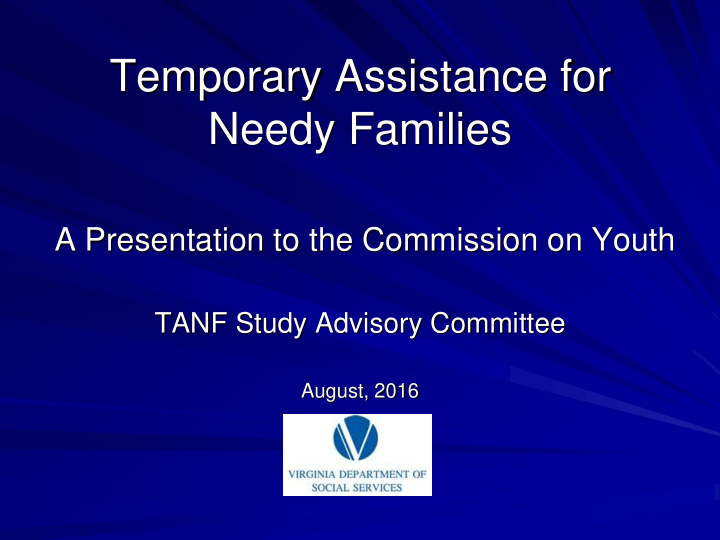



Temporary Assistance for Needy Families A Presentation to the Commission on Youth TANF Study Advisory Committee August, 2016
TANF Origins TANF replaced the Aid to Families with Dependent Children Program with the passage of the Personal Responsibility and Work Opportunity Reconciliation Act of 1996. It changed the program from an entitlement program with very strong federal oversight to a block grant with maximum state flexibility. 2
TANF Goal To maximize opportunities for TANF recipients to gain the training and job skills they need to become self-sufficient by providing supportive services and a benefit that meet the subsistence needs of the family. 3
TANF Overview Provides cash and other assistance to eligible needy families with children. Funded through an annual $158.2 million federal block grant. The state has flexibility to design/fund programs that address the needs of Virginia’s low -income families. State is required to spend $128 million annually in state general funds known as Maintenance of Effort (MOE.) – This represents 75% of the amount the state spent on welfare spending in 1994. 4
TANF Overview TANF programs must meet one of four federal requirements: – Provide assistance to needy families so children can be cared for in their own homes or homes of relatives; – Must end dependence of needy parents on government benefits by promoting job preparation, work and marriage; – Prevent and reduce the incidence of out-of-wedlock pregnancies; and – Encourage the formation of two-parent families. Services under the first two purposes are means-tested and activate work requirements and time limits. 5
TANF Overview There is a 60-month federal lifetime limit on receipt of cash assistance; 2-year state limit. Recipients must participate in a program to enhance their employability as a condition of eligibility for assistance, unless exempt (Virginia Initiative for Employment not Welfare - VIEW.) State must have 50 percent of recipients in an allowable work activity or face federal sanctions. 6
TANF Overview TANF was reauthorized in 2005 – Deficit Reduction Act (DRA); it should have been reauthorized again in 2010 – currently operating on a Continuing Resolution. Last reauthorization implemented significant changes in work requirements – narrowly defined work activities. Changed the baseline for the caseload reduction credit. 7
TANF Benefits The TANF income eligibility threshold is about 20% of the federal poverty limit ($336 for a family of 3.) Virginia’s benefits are 15 th lowest in the nation, only states like Mississippi, South Carolina and Georgia being lower. By comparison, Virginia ranks 11 th highest in per capita income. 3 Locality Groupings – different benefit levels. 8
TANF Funding Conditions Funding for TANF is dependent on the state meeting a 50 percent Work Participation Rate (WPR). Failure to meet the WPR results in a 5 percent reduction in the TANF block grant - $7.9M. Additionally, the state must increase its MOE from 75 to 80 percent of FY 1994 spending - $8M. 9
TANF Work Requirements States can offset their 50 percent WPR with a caseload reduction credit – a percent reduction in the required WPR for each percentage reduction in the caseload since 2005. For FFY 2014, after applying a caseload reduction credit of 17.7 percent, Virginia’s new WPR target became 32.3 percent. Virginia’s actual WPR was 43.9 percent. 10
TANF Uses While a sizeable portion ($74.9M) of TANF funds go to direct services to families under purposes 1 and 2 (cash assistance, employment services, child care), TANF funds are also used for program administration: – State and Local Staff and Operations ($53.6M) – Reserve for new eligibility system ($2M) 11
TANF Uses Under purposes 3 and 4, TANF can be used to fund a variety of programs and services. “Expanded Funding” is currently used for: – Healthy Families ($9.0M) – Domestic Violence ($3.3M) – Community Action Agencies ($4.25M) – Comprehensive Health Investment Project ($2.4M) – Boys and Girls Clubs ($1M) – Resource Mothers ($1M) – EITC Grants ($186K) 12
TANF Uses States may also transfer up to 30% of the block grant for programs under the Child Care and Development Block Grant and Social Services Block Grant: – CCDF for At-Risk child care – ($15.6M) – CCDF for Head Start – ($2.5M) – SSBG for local staff support – ($6.4M) – SSBG for CSA – ($9.4M) 13
TANF Surplus SFY 16 closed with a TANF surplus of $70.5M. There remains a structural imbalance in TANF funding; each year we are appropriating more than we receive in the block grant funding. Projected surpluses: – $48.1M SFY 2017 ($180.6M Appropriated) – $20.7M SFY 2018 (M185.7M Appropriated) 14
TANF Surplus At the height of the recession, October 2011, we were serving over 37,000 households per month ($116M per year.) We are now serving 22,500 per month ($73M FY 2016.) In FY 16 alone, we spent nearly $43M less in TANF cash assistance than we did in FY 12. 15
TANF Surplus- Challenges The challenge with the TANF surplus is making long-term commitments that may not be sustainable. If caseloads start to increase, we must insure that there is sufficient funding to meet the primary purpose of TANF – financial assistance and supportive services to needy eligible families and children. 16
Recommend
More recommend